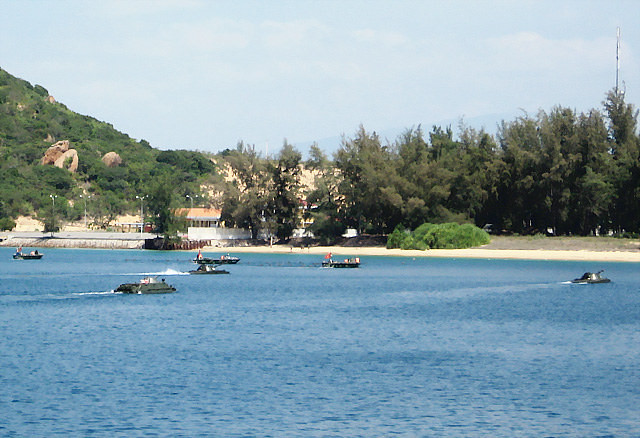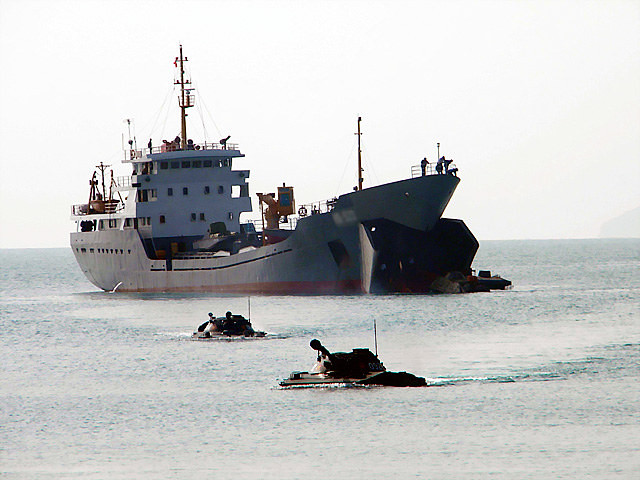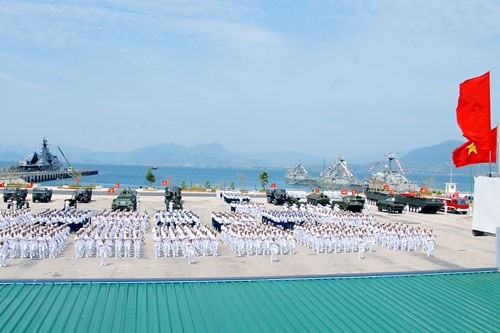Vietnamese People's Navy
The PAVN Navy (The People's Army of Vietnam Navy), begun in 1955 as the PAVN ( The People's Army of Vietnam ) Riverine and Maritime Force, in 1959 became the Coastal Defense Force. Its "tradition day" is celebrated annually on August 5 to mark the 1964 Gulf of Tonkin incident in the Second Indochina War. The PAVN Navy began a buildup in the mid-1960s with the arrival of twenty-eight gunboats from China and thirty patrol torpedo boats from the Soviet Union. At the end of the Second Indochina War, it assumed the normal dual missions of a navy, that is, coastal defense and sea surveillance.
From 1978 to 1990 the PAVN Navy received Soviet assistance and encouragement and was the largest naval force in Southeast Asia, in exchange they allowed the Soviets to use Cam Ranh Bay as a naval base. Including some 1,300 former United States and South Vietnamese naval vessels, naval and civilian junks, and coasters, the PAVN Navy had a total of about 1,500 vessels. Its inventory contained two principal combat vessels, 192 patrol boats, 51 amphibious warfare ships, 104 landing ships, and 133 auxiliary craft.
The command structure of the PAVN Navy originated in Hanoi, where the commander in chief of naval forces was located. His office, the Naval Directorate, reported to the Military general Staff Directorate, i.e., the high command. The top operational Commander was the Commander, Vietnam Naval Forces, headquartered in Haiphong. The two posts were usually held by the same individual. Regulations issued in April 1982 established three flag-rank officers: rear admiral, equivalent to a major general; vice admiral, equivalent to a lieutenant general; and full admiral, equivalent to a colonel general.
Five naval regions made up the operational command. Headquartered at Haiphong, Vinh, Da Nang, Vung Tau, and Rach Gia, each region had two or more naval installations or facilities for which it was responsible. Within this structure were the navy fleets or navy groups, in turn divided into navy brigades. In 1987 the Ham Tu Fleet patrolled the northern Gulf of Tonkin as a strategic deterrent to China; its Chuong Duong Brigade was designed to oppose amphibious landings; its Kiet Brigade was assigned to defend the offshore islands and to perform troop transport duties. The Bach Dang Fleet served in the South. Its Ham Tu Naval Brigade (with 80 percent of its personnel South Vietnamese Navy veterans) operated almost entirely in Cambodian waters.
The Vietnamese People's Navy (VPN) consists of combat and logistic elements having more and more modern vessels, weapons, and equipment which enable it to carry out combat operations in Vietnamese waters. The Vietnamese People's Navy plays an important part in protecting national waters, islands, the continental shelf, and special economic zones and in ensuring the interests of maritime economy. The Vietnamese People's Navy is the lead force in maintaining coordination with other forces such as the police, customs service, border defense force, and maritime police to strictly control national waters and economic activities at sea in compliance with Vietnamese and international laws.
In 2006, the Vietnamese Navy consisted of about 27,000 naval infantry, 9,000 regulars, and 3,000 conscripts. The fleet is arranged into four main regions as follows: Haiphong (headquarters), Da Nang, Nha Trang, and Cân Tho. Ther are also bases in Cam Ranh Bay, Hue and Ha Tou.
Despite Vietnam's significant maritime interests such as its claim to the Spratly Islands in the South China Sea, a heavily disputed area, the People's Navy is relatively weak. With a short supply of spares and many of its ships barely able to claim operational ability, its operational capability fails to live up to the Navy's Order of Battle. The relationship which began during the Cold War with the Soviet Union is still of great importance, at the very least in order to maintain a minimal operational readiness.
It does not seem likely that Vietnam will invest heavily to improve the navy's operational capabilites, as there is an absence of any recent territorial disputes with China, and a general lack of direct threats. However, the topic of control over the South China Sea and more specifically, the Spratly Islands, may prove to be an incentive for some such investment to take place.

In 2011, the Vietnam People's Navy received two modern Gepard class frigates, these are the largest, most modern warships in Vietnam. In the photo, missile ship HQ-011 Dinh Tien Hoang (source: Newspaper QĐND).
Vietnam became Russia's biggest arms client in 2009, having ordered six diesel-electric submarines and 12 Su-30 fighter jets. In April 2009 the Russian business daily Kommersant reported that Admiralty Shipyards in St. Petersburg will build six Kilo class diesel-electric submarines for delivery to Vietnam. The paper quoted company general director Vladimir Aleksandrov as saying that Russia's state arms exporter Rosoboronexport would soon sign a contract with a foreign state, and that Admiralty Shipyards had been chosen to fulfill this contract. Sources in Rosoboronexport later confirmed that Russia and Vietnam had been negotiating a $1.8 billion deal on the delivery of six Kilo-class submarines to the Vietnamese navy for about a year. The submarine is designed for anti-submarine warfare and anti-surface-ship warfare, and also for general reconnaissance and patrol missions. The vessel has a displacement of 2,300 tons, a maximum depth of 350 meters (1,200 feet), a range of 6,000 miles, and a crew of 57. It is equipped with six 533-mm torpedo tubes. As of November 2006, 16 of the vessels were believed to be in active service with the Russian Navy and eight submarines were thought to be in reserve. Another 29 vessels have been exported to China, India, Iran, Poland, Romania and Algeria.
Russia will start supplying Kilo class diesel submarines to Vietnam in 2014, a representative of state-run arms exporter Rosoboronexport said in July 2011. The submarines are equipped with "Club-S cruise missile systems," Oleg Azizov said. Russia and Vietnam signed a $3.2-billion contract on the delivery of submarines in December 2009 during the visit of Vietnamese Prime Minister Nguyen Tan Dung to Russia. This is the largest deal in the history of Russian exports of naval equipment.
Two contracts on the supply of Gepard class frigates to Vietnam rank second and third on the list of Russia’s 2011 military contracts made by the Center for the Analysis of the World Arms Trade (TsAMTO). Gepard 3.9 frigate. It is currently in service with the Russian and Vietnamese Navies. The frigate is equipped with a new-generation combined gas turbine power plant and can move at up to 28 knots. Owing to its combat and operational capabilities, the ship can remain at sea for long time, control vast sea areas and operate under any climatic conditions. The Gepard-3.9 has been designed in accordance with the Russian Navy’s survivability requirements for actions in any combat situation. The ship has embodied stealth technology to minimize its signature. To accomplish strike missions, the ship is equipped with the Uran-E anti-ship missile system. Its air defenses include the Palma missile/gun system with two 30mm rapid-fire autocannons and the Sosna-R guided missile. The 76.2mm AK-176M gun mount can destroy surface, coastal and air targets. For antisubmarine warfare, the ship is equipped with two twin 533mm torpedo tubes and rocket-assisted ASW system. All the armaments can be employed at sea state up to 5. For strike and ASW missions, the ship can accommodate a helicopter.
Although Vietnam terminated the lease of Cam Ranh Bay to the Russian Navy in mid-2001, there does not seem to be any clear indication of them making this base available to other countries, even though its size is attractive to the US, China, and India, who would all be able to provide significant funding and training opportunities. US-Vietnam relations hint at improvement over recent years with at least three port visits by US warships since the end of the Vietnam War in 1975. Namely, the 2003 visit to Ho Chi Minh City, the 2004 visit to Da Nang, and again in 2005 at Ho Chi Minh City marking the 30th anniversary of the end of the war.
From 1978 to 1990 the PAVN Navy received Soviet assistance and encouragement and was the largest naval force in Southeast Asia, in exchange they allowed the Soviets to use Cam Ranh Bay as a naval base. Including some 1,300 former United States and South Vietnamese naval vessels, naval and civilian junks, and coasters, the PAVN Navy had a total of about 1,500 vessels. Its inventory contained two principal combat vessels, 192 patrol boats, 51 amphibious warfare ships, 104 landing ships, and 133 auxiliary craft.
The command structure of the PAVN Navy originated in Hanoi, where the commander in chief of naval forces was located. His office, the Naval Directorate, reported to the Military general Staff Directorate, i.e., the high command. The top operational Commander was the Commander, Vietnam Naval Forces, headquartered in Haiphong. The two posts were usually held by the same individual. Regulations issued in April 1982 established three flag-rank officers: rear admiral, equivalent to a major general; vice admiral, equivalent to a lieutenant general; and full admiral, equivalent to a colonel general.
Five naval regions made up the operational command. Headquartered at Haiphong, Vinh, Da Nang, Vung Tau, and Rach Gia, each region had two or more naval installations or facilities for which it was responsible. Within this structure were the navy fleets or navy groups, in turn divided into navy brigades. In 1987 the Ham Tu Fleet patrolled the northern Gulf of Tonkin as a strategic deterrent to China; its Chuong Duong Brigade was designed to oppose amphibious landings; its Kiet Brigade was assigned to defend the offshore islands and to perform troop transport duties. The Bach Dang Fleet served in the South. Its Ham Tu Naval Brigade (with 80 percent of its personnel South Vietnamese Navy veterans) operated almost entirely in Cambodian waters.
The Vietnamese People's Navy (VPN) consists of combat and logistic elements having more and more modern vessels, weapons, and equipment which enable it to carry out combat operations in Vietnamese waters. The Vietnamese People's Navy plays an important part in protecting national waters, islands, the continental shelf, and special economic zones and in ensuring the interests of maritime economy. The Vietnamese People's Navy is the lead force in maintaining coordination with other forces such as the police, customs service, border defense force, and maritime police to strictly control national waters and economic activities at sea in compliance with Vietnamese and international laws.
In 2006, the Vietnamese Navy consisted of about 27,000 naval infantry, 9,000 regulars, and 3,000 conscripts. The fleet is arranged into four main regions as follows: Haiphong (headquarters), Da Nang, Nha Trang, and Cân Tho. Ther are also bases in Cam Ranh Bay, Hue and Ha Tou.
Despite Vietnam's significant maritime interests such as its claim to the Spratly Islands in the South China Sea, a heavily disputed area, the People's Navy is relatively weak. With a short supply of spares and many of its ships barely able to claim operational ability, its operational capability fails to live up to the Navy's Order of Battle. The relationship which began during the Cold War with the Soviet Union is still of great importance, at the very least in order to maintain a minimal operational readiness.
It does not seem likely that Vietnam will invest heavily to improve the navy's operational capabilites, as there is an absence of any recent territorial disputes with China, and a general lack of direct threats. However, the topic of control over the South China Sea and more specifically, the Spratly Islands, may prove to be an incentive for some such investment to take place.

In 2011, the Vietnam People's Navy received two modern Gepard class frigates, these are the largest, most modern warships in Vietnam. In the photo, missile ship HQ-011 Dinh Tien Hoang (source: Newspaper QĐND).
Vietnam became Russia's biggest arms client in 2009, having ordered six diesel-electric submarines and 12 Su-30 fighter jets. In April 2009 the Russian business daily Kommersant reported that Admiralty Shipyards in St. Petersburg will build six Kilo class diesel-electric submarines for delivery to Vietnam. The paper quoted company general director Vladimir Aleksandrov as saying that Russia's state arms exporter Rosoboronexport would soon sign a contract with a foreign state, and that Admiralty Shipyards had been chosen to fulfill this contract. Sources in Rosoboronexport later confirmed that Russia and Vietnam had been negotiating a $1.8 billion deal on the delivery of six Kilo-class submarines to the Vietnamese navy for about a year. The submarine is designed for anti-submarine warfare and anti-surface-ship warfare, and also for general reconnaissance and patrol missions. The vessel has a displacement of 2,300 tons, a maximum depth of 350 meters (1,200 feet), a range of 6,000 miles, and a crew of 57. It is equipped with six 533-mm torpedo tubes. As of November 2006, 16 of the vessels were believed to be in active service with the Russian Navy and eight submarines were thought to be in reserve. Another 29 vessels have been exported to China, India, Iran, Poland, Romania and Algeria.
Russia will start supplying Kilo class diesel submarines to Vietnam in 2014, a representative of state-run arms exporter Rosoboronexport said in July 2011. The submarines are equipped with "Club-S cruise missile systems," Oleg Azizov said. Russia and Vietnam signed a $3.2-billion contract on the delivery of submarines in December 2009 during the visit of Vietnamese Prime Minister Nguyen Tan Dung to Russia. This is the largest deal in the history of Russian exports of naval equipment.
Two contracts on the supply of Gepard class frigates to Vietnam rank second and third on the list of Russia’s 2011 military contracts made by the Center for the Analysis of the World Arms Trade (TsAMTO). Gepard 3.9 frigate. It is currently in service with the Russian and Vietnamese Navies. The frigate is equipped with a new-generation combined gas turbine power plant and can move at up to 28 knots. Owing to its combat and operational capabilities, the ship can remain at sea for long time, control vast sea areas and operate under any climatic conditions. The Gepard-3.9 has been designed in accordance with the Russian Navy’s survivability requirements for actions in any combat situation. The ship has embodied stealth technology to minimize its signature. To accomplish strike missions, the ship is equipped with the Uran-E anti-ship missile system. Its air defenses include the Palma missile/gun system with two 30mm rapid-fire autocannons and the Sosna-R guided missile. The 76.2mm AK-176M gun mount can destroy surface, coastal and air targets. For antisubmarine warfare, the ship is equipped with two twin 533mm torpedo tubes and rocket-assisted ASW system. All the armaments can be employed at sea state up to 5. For strike and ASW missions, the ship can accommodate a helicopter.
Although Vietnam terminated the lease of Cam Ranh Bay to the Russian Navy in mid-2001, there does not seem to be any clear indication of them making this base available to other countries, even though its size is attractive to the US, China, and India, who would all be able to provide significant funding and training opportunities. US-Vietnam relations hint at improvement over recent years with at least three port visits by US warships since the end of the Vietnam War in 1975. Namely, the 2003 visit to Ho Chi Minh City, the 2004 visit to Da Nang, and again in 2005 at Ho Chi Minh City marking the 30th anniversary of the end of the war.




20161119 junda
ReplyDeletelouis vuitton pas cher
ferragamo shoes
mulberry bags
polo ralph lauren
fitflop clearance
canada goose outlet
ugg outlet
coach outlet
oakley sunglasses
swarovski crystal
kate spade outlet
ReplyDeletenike outlet
michael kors handbags
colts jerseys
pandora charms
michael kors outlet
red valentino
ralph lauren
nike shoes
michael kors handbags sale